There are now approximately 1.6 million pet rabbits in the UK (PDSA,2011), making them the third most popular mammalian pet after dogs and cats (Sayers, 2010). Unfortunately most owners still do not go to their local veterinary practice for routine advice or for medical attention for their rabbit. Furthermore, the level of owners' knowledge and their understanding, or lack of it, about how to look after their rabbit properly is considered to be an important contribution to the cause of the poor health of these animals (Edgar and Mullan, 2011). Many rabbits are still kept traditionally as children's pets, in a hutch in the garden, fed on concentrate food. These hutch conditions are often woefully inadequate and fail to provide for the animal's mental and physical needs. However, in the authors' opinion even this trend is changing as more and more pets are kept as house rabbits by adults.
Good quality, accurate advice dispensed when clients visit the surgery is important. Unfortunately it is not common for newly acquired pet rabbits to visit the vets for a check up in the way that puppies and kittens do, which means that it is essential to find other opportunies for providing advice. Rabbit clinics are a logical place for the veterinary nurse to spend time ensuring that the client receives this advice and the rabbit has a thorough check over. Good rabbit consultations are likely to mean that rabbits live longer healthier lives, through ensuring that good husbandry minimizes common problems such as obesity and dental disease, and also help bond a client to the practice.
Pre consultation considerations
Although domesticated for decades, rabbits' behaviour has changed little, and they are easily frightened, and quickly stressed. The effects of stress are significant and can lead to heart failure and death (Harcourt–Brown, 2002) as well as many more subtle longer-term problems. Many of the problems related to stress in rabbits are due to the release of corticosteroids and catecholamines. Stimulation of the sympathetic nervous system leads to reduced gut motility which in turn has a knock on effect, with gut stasis, enterotoxaemia and mucoid enteropathy all occurring (Harcourt–Brown, 2002).
Advice given by staff prior to any trip to the vets must be aimed at minimizing stress, by careful preplanning of the consultation (Table 1).
| Solid carrier |
| Newspaper and straw/hay bedding |
| Bring sample of normal food |
| Consider fresh food and if a prolonged period of time, then water should be available |
| Cover carrier to provide seclusion |
| Prevent heat stroke issues |
| Bring a familiar toy or used bedding |
| Do not starve prior to surgery |
Transporting rabbits to the veterinary practice
Carriers should be rigid, non-collapsible, well ventilated and secure to ensure that rabbits cannot chew them or escape. Size should be sufficient to allow the rabbit to enter easily, lie comfortably in any direction and turn around unimpeded. However, at the same time the carrier should be small enough to provide feelings of security. With giant breeds of rabbit this may lead to conflict with the practicalities of moving such a large carrier, and compromise will need to be reached.
If open grilled on the top, then partially covering the carrier with a towel will help to recreate the feelings of the safety of a dark burrow.
The carrier should be lined with newspaper to absorb urine, and then a small amount of normal bedding such as straw, put in to allow continuity of smells.
Rabbits do not tolerate heat well, so owners need to ensure that their vehicle is kept cool, well ventilated, and where practical they should be advised to avoid transport during the hottest parts of the day. Rabbits tolerate cold weather very well, their dense coat insulating them. However they do not sweat and cannot pant effectively, so their ears play an important part in thermoregulation. Rabbits with heat stroke show similar signs to other species: anorexia, increased respiratory rate, and prostration and cyanosis (Harcourt–Brown, 2002).
Minimizing rejection
Rabbits are territorial animals, and if a rabbit is taken out of a group housed situation, then it could be rejected by the others if it smells different on return. To minimize this, either advise the owner to place familiar items in the carrier with them, such as their favourite toy and some used bedding (Figure 1), or where practical bring the other rabbit along at the same time. When hospitalizing a sick rabbit always consider asking the owners to bring a bonded companion as company, as well as an appropriate amount of normal food for the rabbit's stay.
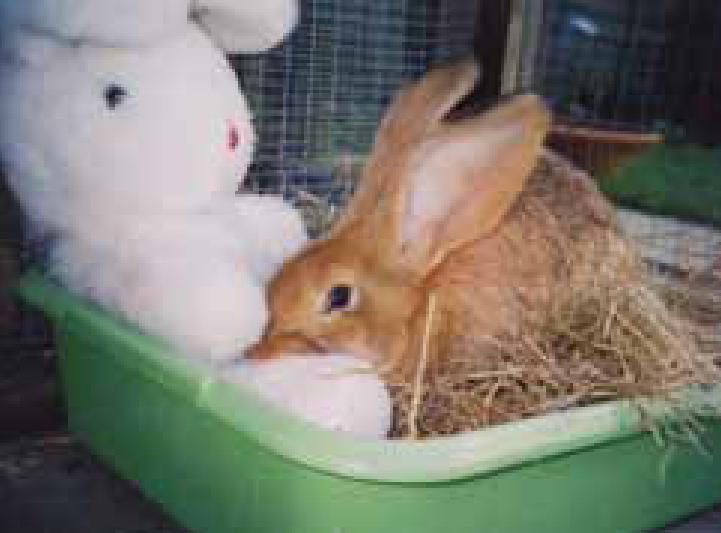
Pre-consultation feeding
Owners should, however, be asked not to feed their rabbits for a couple of hours prior to the consultation to ensure that there is no food material in the mouth. This makes examining their teeth much easier.
Making the practice a rabbit-friendly environment
The waiting room
Arrange non-urgent appointments for rabbits at a quiet time of day or group rabbit appointments together, at the beginning or end of consultations. This avoids mixing them with predators (e.g. dogs, cats and ferrets) or other noisy animals that may cause the rabbits distress.
Ideally it would be nice to provide a separate waiting area and ‘rabbit ward'. Alternatively consider asking the owner to wait in their car with their rabbit(s) (assuming it is cool and well ventilated) until you are ready to collect them for their appointment.
The consultation
During the consultation ideally leave the carrier on the floor, allowing the rabbit to come out on its own and explore the room to familiarize itself with its surroundings.
Always put a non slip surface down on the consultation table for the rabbit to walk on. Ideally this should be a large towel that covers the surface of the table affording some grip. In addition, putting some bedding down will make them feel more comfortable, however, this can be messy (Table 2).
| Unfamiliar surroundings, loud noises and predators all stress rabbits |
| Batch rabbit consultations to create rabbit clinics |
| Open the carrier on the floor and allow the rabbit time to come out |
| Always use a non slip surface on the consulting room table (eg towel) |
| Support the rabbits' rear end when lifting |
| Allow the rabbit to run around on the floor when not being examined |
Handling
Most pet rabbits are used to human contact, and do not mind being picked up and handled. This should be done in a quiet, calm and confident manner, avoiding any sudden movements or loud noises. Rabbits can be lifted out of their carrier either by placing a hand round either side of the chest and lifting them, in much the same way as a small dog or cat. However, it is better to support their rear end, because if rabbits kick out, they can injure themselves (Figures 2 and 3). Rabbits should never be picked up by their ears. When carrying a rabbit it is best to hold them firmly against the body. Tucking their head under the elbow gives them a sense of security and minimizes struggling.
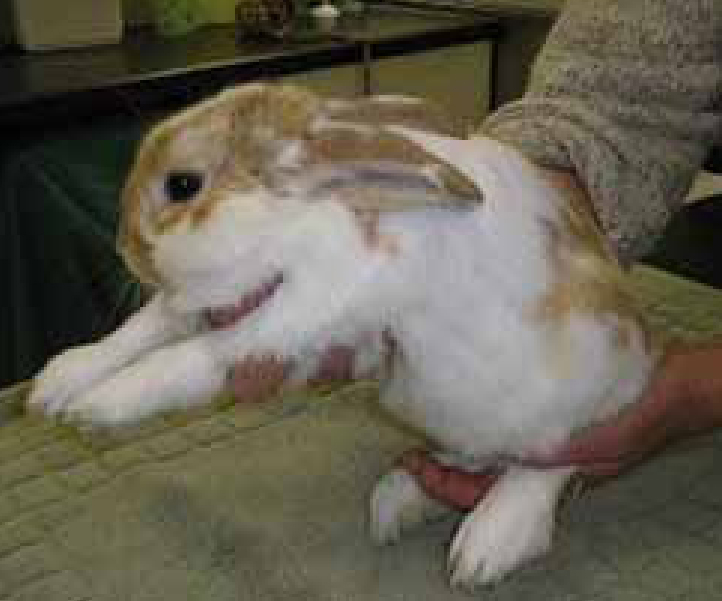
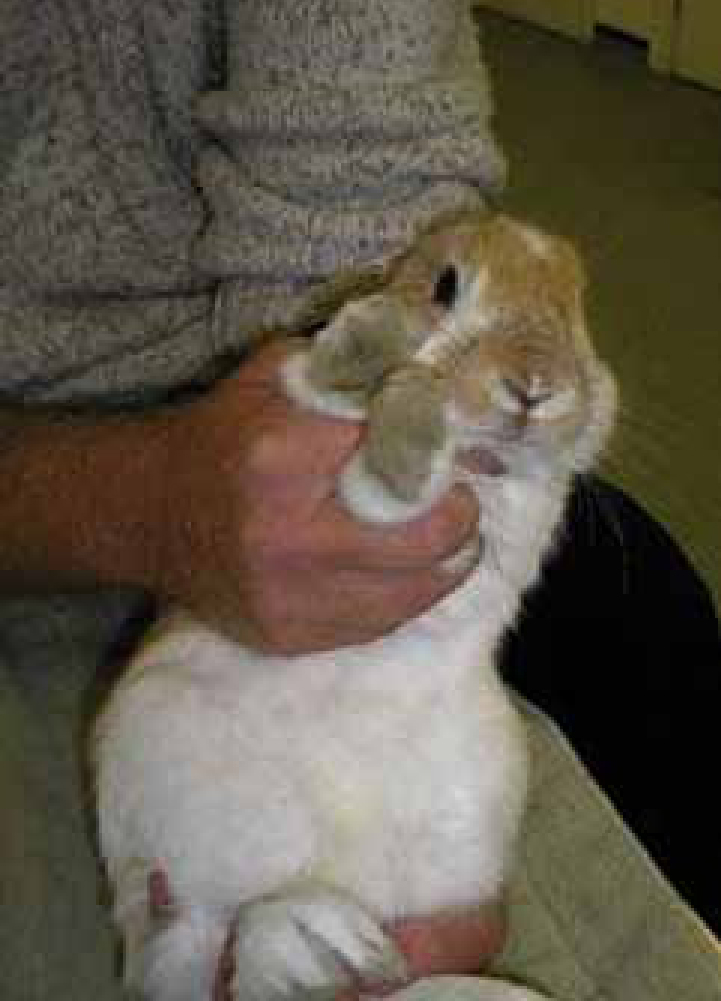
Rabbits are nasal breathers so it is important never to cover their nostrils.
If a rabbit is scared and struggling then wrapping them in a towel to aid controlling them helps minimize stress, and allows a thorough examination (Jackson, 1991) (Figure 4).
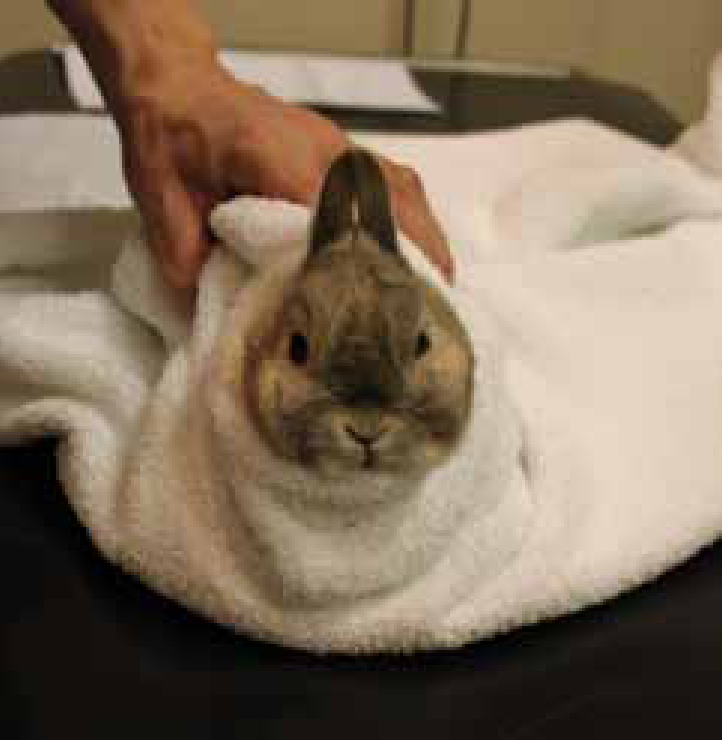
Tipping a rabbit on its back can often invoke an immobility response, trancing or tonic immobility (Figure 5). This is a controversial procedure, as some argue (Harcourt-Brown, 2002) that this is a stress reaction used by rabbits when they think they are going to be eaten. Its use should be limited to non invasive situations where the use of the immobility response is considered less stressful for the rabbit. However, the authors find it useful in some circumstances, such as clipping toe nails or examining the ventral abdomen.
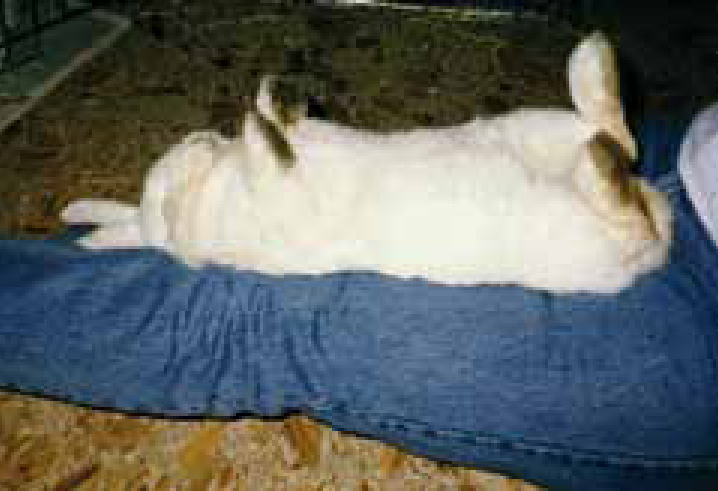
Once the examination has been completed the rabbit should be placed back on the floor, allowing them to return to their carrier or examine the consulting room; giving them a period of time to relax when they are not being handled.
History and areas for discussion
As with dogs and cats a full history is important to build up a picture of the lifestyle and conditions in which the rabbit is kept (Table 3). However, it is not always simple to elicit an accurate history as many owners can have preconceived ideas about how their rabbit should or should not be kept. For example, many will not wish to admit that the rabbit has not been out of its hutch for months, nor received any fresh vegetables since last summer. Asking the owner to bring in photographs of the enclosure in which the rabbit is kept is a helpful way to evaluate husbandry issues that may affect health. It also allows better communication with the clients about exactly what may need to be improved.
| Housing, shape and size and position |
| House rabbit or garden rabbit |
| Sex of rabbit |
| Age |
| Nature of rabbit |
| Bedding |
| Access to exercise and environmental enrichment |
| Single or multiple housed |
| Housed with other species |
| Diet |
| Length of ownership |
| Over-winter accomodation |
| Vaccination, myxomatosis and viral haemorrhagic disease |
| Neutering, male and female |
| Housing, size of house, Bedding, and access to exercise area |
| Access to grass |
| Diet: grass/hay, extruded nuggets, fresh water, fresh vegetables, treats |
| Grooming |
| Prevention of fly strike |
| Prevention/treatment of E. cuniculi |
| Insurance |
Neutering
Vaccinations
Housing
Diet
Socialization
Careful questioning, combined with gentle education is, essential. A good history is particularly important with rabbits as so many of their medical problems, such as obesity, pododermatitis, and gastrointestinal disorders, stem from poor husbandry.
The health check
In a similar way to gaining the history, a full health examination is important. Developing a systematic approach, and always following this protocol means you are less likely to miss something. The authors start at the back end, for no other reason than the fact that ascertaining the correct sex often leads to a protracted discussion. Mis-mating and unwanted pregnancies are common, and the authors find this is better discussed at the start of the consultation than the end.
Wherever you start, particular attention should be paid to the mouth and teeth. Rabbits' teeth grow continuously throughout their life, and a high fibre diet is essential to assist in dental wear. Inappropriate diet, as well as inherited maloclussion, means that dental issues are common. Obesity is particularly common (affecting possibly as many as one in four) as most rabbits lead a sedentary life. The extra weight, as with cats and dogs, leads to serious life-threatening conditions, such as heart disease, gut motility, digestion and bed sores, pododermatitis (Harcourt-Brown, 2002).
A check list is given to cover the areas that should be examined (Table 5).
| Confirm sex, male/female | |
| Check for leg rings, ear tags, microchips and tattoos | |
| Check eyes, ears, nose | |
| Examine mouth and teeth: | External palpation of mandible |
| Visual examination of incisors | |
| Visual examination of molars | |
| Check coat and skin | |
| Weight | |
| Heart rate | |
| Respiratory rate and sounds | |
| Abdomen | |
| Legs, especially for pododermatitis and claws |
Conclusion
Setting up and running rabbit clinics are simple to do. Their impact on the welfare and health of rabbits can be enormous, with the rewards far outweighing the time and effort spent. Many of the problems that pet rabbits suffer from are due to basic husbandry, unlike dogs and cats, which means that these cases are perfect for veterinary nurses who can have a huge impact on the way these small animals are cared for, to the benefit of the owners, the practice and most importantly of all the rabbit.
